Thermal shut-off valve on the gas pipeline: purpose, device and types + installation requirements
Gas is not only an affordable fuel, but also an extremely explosive substance. Therefore, it is so important that every gasified facility meets safety requirements. Do you agree? After all, if a high temperature rises in the gas pipeline section (when something is ignited) and the gas ignition limit is reached, then explosion is inevitable.
To prevent such a development of the situation, a thermal shutoff valve on the gas pipeline will help. This device cuts off the gas supply in case of fire, which means that eliminates the risk of explosion. Next, we will tell you how such valves are arranged, what types are and how to install them correctly on gasified facilities.
The content of the article:
Why are thermal shutoff valves necessary?
Thermal shutoff valves - devices that are gas shutoff valves. They automatically shut off the gas pipeline leading to all gas-powered appliances.
All "stubs" are marked as KTZ with a specific set of numbers after the letters. The second number indicates the diameter of the gas pipe for which this mechanism may be suitable.
Purpose of the thermal shut-off valve
The main purpose of KTZ is to shut off the gas supply to the equipment in the event of a fire. Which helps not only to protect against explosion, but also does not allow to increase the area of fire twice or more.
If the shut-off valve is in the open position, then the device itself does not interfere with the passage of the combustible substance to the instruments and equipment.
Thermal locking mechanisms are mounted on pipelines, where the maximum pressure can be 0.6 MPa - 1.6 MPa.
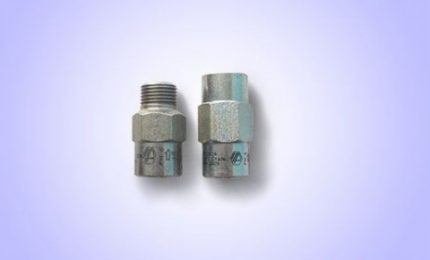
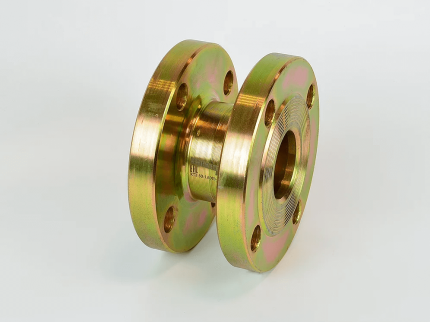
Next, we designate the purpose of the shutoff valves prescribed by the rules of the fire authorities.
In regulations on fire safety rules, there is a regulation that involves the use of valves:
- On the equipment of all natural gas pipelines. Any types of systems (complexity, ramification), any number of consumer devices are assumed.
- To ensure the protection of various gasified objects and devices operating from gas. In this case, valves that are designed to automate (actuation) when the temperature in the room reaches 100 ° C are applicable.
- Installation of thermal isolation modules at the entrance to the room.
In accordance with PPB-01-03 (Fire safety regulations) thermal shut-off devices must be installed in all rooms where there is a gas pipeline. However, this does not include buildings of the V category of fire resistance.
It is also not necessary to install KTZ in buildings where pipelines are equipped with solenoid valves. They are usually placed outside the building, and if ignition occurs inside the building, it works gas analyzerthen the gas supply stops.
It should be understood that KTZ is not another Russian “trend”. The use of these devices at various business facilities where gas equipment exists is mandatory in countries such as Germany, France, the USA, etc.
Where is the thermal shut-off valve used?
The scope of gas shut-off plugs is, first of all, pipelines supplying gas to various devices for which gas is burned (household and industrial devices, regardless of type).
The installation of KTZ on any gas pipeline is not permissible outside the premises, after the installation of any other gas fittings, also on bypasses, in adjacent rooms and where the working air temperature under the influence of gas equipment can reach more than 60 ° C.
It is important not to violate the installation rules - the shut-off valve is installed first on the gas pipeline, and only after it the rest gas fittings, appliances and equipment. The valve can be positioned in different positions, but you should pay attention to the arrow pointer marked by the manufacturer on the body.
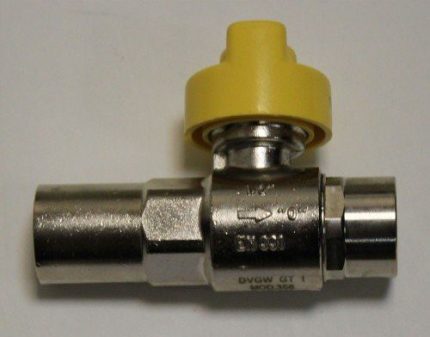
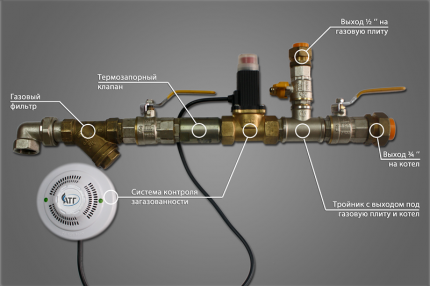
In relation to the horizon, the location of the installed valve can be any. On the rules for installing KTZ in more detail we will describe further.
Thermal shutoff valves have a special design, which allows the device to automatically shut off the gas supply at the right time. If you get acquainted with the design features of the valves, you can quickly understand the essence of their action. Next, we will analyze in more detail.
CTZ device and principle of operation
The valve design includes a steel body with a threaded connection, a melt insert, a spring element located inside the body, as well as a plate or ball shutter. It is this gate element (indicated last) that serves as one of the main ones, since it locks the channel if necessary.
In the photo below you can see two different types of thermal shutoff valves and the subtleties of their device.
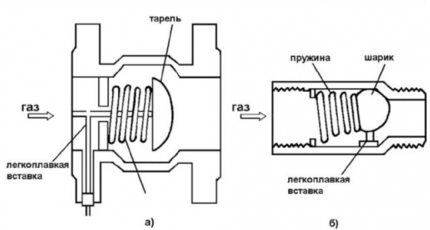
Now let's talk about how the thermal shutoff valve works.
When the room temperature is normal and there is no risk of explosion (ignition, fire, etc.), the valve shut-off is cocked and the insert melts to hold it.If the ambient temperature in the building rises, reaching 80-100 ° C, then this entails the expansion of the insert, which we are talking about. This is the release of the cutting mechanism, which in turn, due to the action of the spring, closes the gas access to the equipment.
The tightness of the actuated valve is ensured by pairing the valve cones and the valve seat, in a word, as "metal to metal".
Such shut-off devices may be connected to the pipeline by various types of connections. This can be a flange, sleeve (threaded) or wafer mount. Below we will analyze what types of thermal shutoff valves are generally.
Types of thermal shut-off valves
Currently, there are only two types of thermal shutoff valves on the market. From the descriptions above it’s clear that this coupling valves and flanged.
Each species has its own size range. The main difference between one species from another is the scope. That is, threaded devices are used more often for domestic purposes, and flanged ones - in factories.
This is due to conditional pressure indicators that can withstand locking mechanisms during operation:
- coupling valves - 0.6 MPa;
- flanged valves - 1.6 MPa.
Both types have the same design with the inclusion of a spring, a locking element, a fusible insert and other elements. However, the difference is visible externally in the diameter of the bore.
If more about the scope, then the following places and industries should be distinguished, depending on the type of KTZ:
- Threaded valves are used in the installation of a gas pipeline in residential buildings, boiler houses, industrial facilities for various purposes.
- KTZ with flange connection are used in the installation of a gas pipeline in large boiler rooms and at industrial facilities of a large area.
The second type of valves is more in demand in the industrial sector due to the large diameter of the bore. If for threaded gates it varies between 15-50 millimeters, for flanged valves this indicator can be from 50 to 200 millimeters.
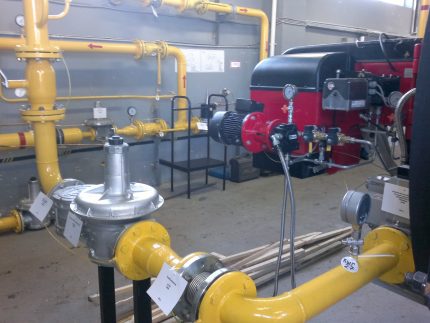
The connection of the inlet flange of the thermal shut-off valve with the counterflange of the pipeline must be sealed with a special heat-resistant gasket. It can withstand up to 900 ° C in case of fire.
The gaskets mentioned are made of special heat-resistant material. The composition includes reinforced graphite in a foil shell, as well as the stainless steel from which this foil is made.

What is the first, that the second version of locking devices can work with any gases. After the mechanism is activated, the valve is changed, installing the same new one in its place. In some cases, it is sufficient to replace the fuse-link for further operation of the actuated valve.
Basic installation rules
The quality of the subsequent operation of the valve depends on the installation process. Therefore, it is important to follow the rules when installing a thermal shut-off valve.
Next, we consider the basic rules and regulations of the KTZ installation on the gas pipeline:
- Thermal locking devices of a threaded connection should be installed only on lines with a pressure of not more than 0.6 MPa. Flanged valves can and should be used on gas pressure pipelines from 0.6 to 1.6 MPa.
- The throughput of the gas line must match the throughput of the valve itself.
- Installation is permitted only indoors to protect fittings that are not designed for high heat.
- KTZ installation is not allowed where adjacent elements raise their ambient temperature to 52 ° C and higher.
- Upon completion of the installation process, it is important to check the valve for leaks.
- The installed valve must be located in a place accessible to humans (for inspection and maintenance).
- The valve should not be subjected to various influences.
It should also be borne in mind that during transportation of thermal shut-off valves, an automatic operation of the mechanism may occur. Therefore, when choosing a device, it is important to check the mechanism.
If the gas distribution is complicated, and there are several consumers of fuel, and the objects are located in different parts of the building, then you will need to install valves on each branch.
And although this shut-off valve undergoes thorough and numerous checks, and is also certified and approved for its intended use, each rule for their installation must be observed.
Conclusions and useful video on the topic
What you need to know about KTZ for domestic use:
Every day, fires claim the lives of thousands of people around the world. Explosions of gas during fires are no less terrible. If each user were more responsible fire safety regulations, then perhaps deplorable outcomes would become less. Thermal shutoff valves can be considered equipment that greatly enhances the security of your home. But for this it is important to follow each rule for their operation and installation, which we talked about in this article.
Do you have questions about the device or the installation rules for the thermal shut-off valve? Or want to supplement the material with useful information? Write your comments in the comments section, ask your questions to our experts, take part in discussions.

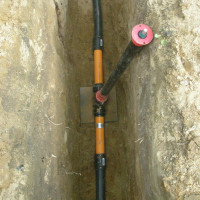 Control pipe on the gas pipeline: purpose + installation rules on the case
Control pipe on the gas pipeline: purpose + installation rules on the case 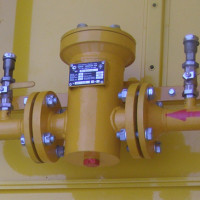 Gas filters: types, device, purpose and features of the choice of filter for gas
Gas filters: types, device, purpose and features of the choice of filter for gas 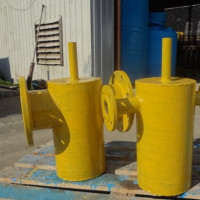 Gas condensate collectors on the gas pipeline: structure and purpose of the condensate collector + nuances of installation and maintenance
Gas condensate collectors on the gas pipeline: structure and purpose of the condensate collector + nuances of installation and maintenance 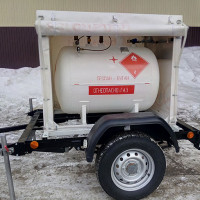 Mobile gas tank: purpose, design and installation features, placement requirements
Mobile gas tank: purpose, design and installation features, placement requirements  Gas cylinder cabinet: cylinder storage requirements + cabinet selection and installation tips
Gas cylinder cabinet: cylinder storage requirements + cabinet selection and installation tips 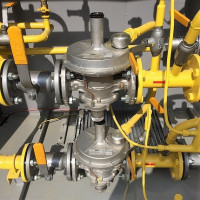 Gas pressure relief valve: types of devices + selection guidelines
Gas pressure relief valve: types of devices + selection guidelines  How much does it cost to connect gas to a private house: the price of organizing gas supply
How much does it cost to connect gas to a private house: the price of organizing gas supply  The best washing machines with dryer: model rating and customer tips
The best washing machines with dryer: model rating and customer tips  What is the color temperature of light and the nuances of choosing the temperature of the lamps to suit your needs
What is the color temperature of light and the nuances of choosing the temperature of the lamps to suit your needs  Replacement of a geyser in an apartment: replacement paperwork + basic norms and requirements
Replacement of a geyser in an apartment: replacement paperwork + basic norms and requirements